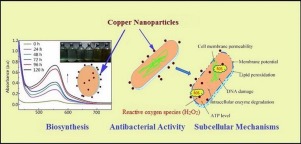Journal of Hazardous Materials ( IF 12.2 ) Pub Date : 2017-12-29 , DOI: 10.1016/j.jhazmat.2017.12.070 Qing Lv , Baogang Zhang , Xuan Xing , Yingxin Zhao , Ruquan Cai , Wei Wang , Qian Gu

|
Metallic nanoparticle based disinfection represents a promising approach for microbial pollution control in drinking water and thus, biosynthesis of non precious metal nanoparticles is of considerable interest. Herein, an original and efficient route for directly microbial synthesis of copper nanoparticles (Cu-NPs) by Shewanella loihica PV-4 is described and their satisfactorily antimicrobial activities are established. Cu-NPs were successfully synthesized and most of them attaching on the bacterial cell surfaces suggested extracellular Cu(II) bioreduction mainly contributed to this biosynthesis. Using a suite of characterization methods, polycrystalline nature and face centered cubic lattice of Cu-NPs were revealed, with size in the range of 10-16 nm. With Cu-NPs dosage of 100 μg/mL and 105 CFU/mL fresh Escherichia coli suspension, the obtained antibacterial efficiency reached as high as 86.3 ± 0.2% within 12 h. Cell damages were primarily caused by the generated reactive oxygen species with H2O2 playing significant roles. Both cell membrane and cytoplasm components were destroyed, while the key inactivation mechanisms were lipid peroxidation and DNA damage as concluded through correlation analysis. The cost-effective and eco-friendly biosynthesis of Cu-NPs with high antibacterial activities make them particularly attractive for drinking water disinfection.
中文翻译:

带有抗菌活性的希瓦氏乳杆菌PV-4生物合成铜纳米颗粒:新方法和机理研究
基于金属纳米颗粒的消毒代表了一种饮用水中微生物污染控制的有前途的方法,因此,非贵金属纳米颗粒的生物合成引起了人们的极大兴趣。在此,描述了通过Shewanella loihica PV-4直接微生物合成铜纳米颗粒(Cu-NPs)的原始有效途径,并建立了令人满意的抗菌活性。Cu-NPs已成功合成,并且大多数附着在细菌细胞表面,表明细胞外Cu(II)的生物还原主要是这一生物合成的原因。使用一套表征方法,揭示了多晶性质和Cu-NPs的面心立方晶格,尺寸在10-16 nm范围内。Cu-NPs剂量为100μg/ mL且10 5CFU / mL新鲜大肠杆菌悬液,在12 h内获得的抗菌效率高达86.3±0.2%。细胞损伤主要是由生成的活性氧引起的,其中H 2 O 2发挥重要作用。通过相关分析得出结论,细胞膜和细胞质成分均被破坏,而关键的失活机制是脂质过氧化和DNA损伤。具有高抗菌活性的具有成本效益和生态友好的生物合成铜纳米粒,使其特别适合饮用水消毒。











































 京公网安备 11010802027423号
京公网安备 11010802027423号